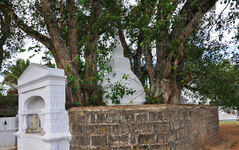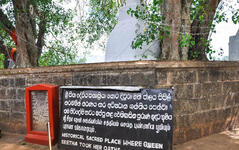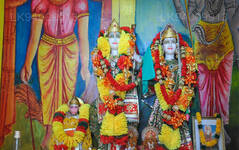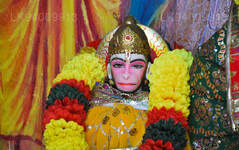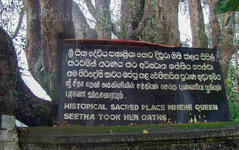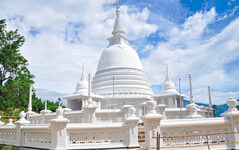
Kandy City
Kandy, a picturesque city in central Sri Lanka, is renowned for its rich cultural heritage, vibrant festivals, and scenic beauty. Nestled amidst lush hills, it is home to the Temple of the Tooth Relic, a UNESCO World Heritage Site, and offers a captivating blend of history and natural splendor.
Divurumpola Temple
Divurumpola is a Buddhist Temple located close to Welimada town (4 KM) on Nuwara Eliya – Badulla main road in the Central Province of Sri Lanka. Divrumpola temple or Divrumpola Raja Maha Viharaya is directly connected with Ramayana trail in Sri Lanka. According to the Ramayana in Sri Lanka It is believed that Divurumpola temple is the place where Sita underwent the famous fire ordeal Agni Pariksha or “Agni” test in order to prove her chastity to God Rama after being rescued by him where she came unscathed and proved her innocence and purity. Considering these historical factors, Divurumpola is one of the important Ramayana Historical places in Sri Lanka. In Sinhala language Divurumpola means a “Place of oath”.
Divurumpola Temple (Raja Maha Viharaya) is a major religious site for Hindus. This temple is a revered site and hundreds of Hindus visit it daily. Divurumpola Raja Maha Viharaya is also a Buddhist temple and we can find some Buddhist stupas and sculptures of Buddha in the complex. There are sculptures of Hindu God Rama, Devi Sita, and Lord Hanuman here. From here we can clearly see the Isthreepura Mountain where Sita was held captive in a cave castle. So this place is considered as the Ramayana sites in Sri Lanka . Today this Buddhist Temple is worship by both Buddhist and Hindu people of Sri Lanka and this Ramayana Site is considering as one of the Ramayana Historical Place in Sri Lanka.
LocationIt is situated 20 Km from Nuwara Eliya Welimada road which can be accessed by Turn off near 96th Km post.
LegendsLegend Ramayanaya love story says that after message of Ramas victory over Ravana was sent to Sita she was taken on a palanquin before Rama after a bath and adorned with jewels. She was overcome with emotions as she was meeting her husband after such a long time. But Rama seemed lost in thought. Sita was shocked at the word he spoke. “I have killed my enemy. I have done my duty as s true king. But you have lived for a year in this enemy’s abode. It is not proper I take you back now”.
Then sita Devi answered “You have broken my Heart, only the uncultured speak like this. Have you forgotten the noble family I come from? Is it my fault Ravana carried me off by force? All the time my mind, my heart, and soul were fixed on you alone, my lord!
Ramayanaya facts states that she turned with tears streaming from her eyes to Lakshmana and said Please prepare a fire for me. That will be the only remedy for this no softening, he lighted a big fire. Sita reverently went round her husband and approached the blazing fire joining her palms in salutation, with these words she jumped into the flames and said, “If I am pure, fire will protect me.” From the flames arose the fire god Agni who was invoked by Sita. He lifted her from the flames unharmed and presented her Lord Rama.
Significant of DivurumpolaA sapling of the Anuradhapura Bodhi tree was planted as a mark of respect this place. A small dagoda (Stupa or Pagoda type building) has been built subsequently under the Bodhi tree. The temple there depicts paintings of the Ramayanaya story Sri Lanka related stories. After the sacred site of Ashok Vatika, this place of Divurumpola is the second most crucial site in the Ramayana Yatra sites in Sri Lanka.
About Kandy District
Kandy district is situated in the centrel province of Sri Lanka. One of the seven World Heritage Sites in Sri Lanka, Kandy was once home to the Kandyan Kings of yore in the 16th-century and a fountainhead for all the music, arts, crafts and culture in the country. About 129 km away from Colombo, Kandy is ensconced amongst a hilly terrain and all eyes are drawn to the centre of the city, where the Kandy Lake forms a charming feature. Kandy retains great religious significance for Sri Lanka, because it is in this charming city that the Dalada Maligawa or "Temple of the Tooth" is located, within which the sacred tooth relic of Lord Buddha lies well guarded.
The Royal Botanical Garden, Peradeniya is situated about 5 km to the west of the city centre at Peradeniya and is visited by 1.2 million people per year. It is the largest botanical garden on the island. The Udawatta Kele (Udawatta Forest) is a protected sanctuary situated in the heart of the city, just north of Temple of the Tooth.
Kandy is a Sinhala majority city; there are sizeable communities belonging to other ethnic groups, such as Moors and Tamils. Kandy is second only to Colombo the center of the Sri Lankan Economy. Many major co operations have large branch officers in Kandy and many industries include textiles, furniture, Information Technology and jewellery are found here. Many agriculture research centers are located in the city.
And a fountainhead for all the music, arts, crafts and culture in the country. About 129 km away from Colombo, Kandy is ensconced amongst a hilly terrain and all eyes are drawn to the centre of the city, where the Kandy Lake forms a charming feature. Kandy retains great religious significance for Sri Lanka , because it is in this charming city that the Dalada Maligawa or Temple of the Toothis located, within which the sacred tooth relic of Lord Buddha lies well guarded.
About Central Provincce
The Central Province of Sri Lanka consists primarily of mountainous terrain. The province has an area of 5,674 km², and a population of 2,421,148. Some major towns include Kandy, Gampola (24,730), Nuwara Eliya and Bandarawela. The population is a mixture of Sinhalese, Tamil and the Moors.
Both the hill capital Kandy and the city of Nuwara Eliya are located within the Central Province as well as Sri Pada. The province produces much of the famous Ceylon tea, planted by the British in the 1860s after a devastating disease killed all the coffee plantations in the province. Central Province attracts many tourists, with hill station towns such as Kandy, Gampola, Hatton and Nuwara Eliya. Temple tooth or Dalada maligawa is the main sacred place in Centrel province.
The climate is cool, and many areas about 1500 meters often have chilly nights. The western slopes are very wet, some places having almost 7000 mm of rain per year. The eastern slopes are parts of the mid-dry zone as it is receiving rain only from North-Eastern monsoon. The Temperatures range from 24°C at Kandy to just 16°C in Nuwara Eliya, which is located 1,889 m above sea level. The highest mountains in Sri Lanka are located in the Central Province. The terrain is mostly mountainous, with deep valleys cutting into it. The two main mountain regions are the central massif and the Knuckles range to the east of Kandy.

